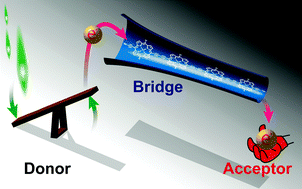Photoinduced charge and energy transfer in molecular wires
Abstract
Exploring charge and energy transport in donor–bridge–acceptor systems is an important research field which is essential for the fundamental knowledge necessary to develop future applications. These studies help creating valuable knowledge to respond to today's challenges to develop functionalized molecular systems for artificial photosynthesis, photovoltaics or molecular scale electronics. This tutorial review focuses on photo-induced charge/energy transfer in covalently linked donor–bridge–acceptor (D–B–A) systems. Of utmost importance in such systems is to understand how to control signal transmission, i.e. how fast electrons or excitation energy could be transferred between the donor and acceptor and the role played by the bridge (the “molecular wire”). After a brief description of the electron and energy transfer theory, we aim to give a simple yet accurate picture of the complex role played by the bridge to sustain donor–acceptor electronic communication. Special emphasis is put on understanding bridge energetics and conformational dynamics effects on the distance dependence of the donor–acceptor electronic coupling and transfer rates. Several examples of donor–bridge–acceptor systems from the literature are described as a support to the discussion. Finally, porphyrin-based molecular wires are introduced, and the relationship between their electronic structure and photophysical properties is outlined. In strongly conjugated porphyrin systems, limitations of the existing electron transfer theory to interpret the distance dependence of the transfer rates are also discussed.

- This article is part of the themed collection: Molecular Wires

 Please wait while we load your content...
Please wait while we load your content...